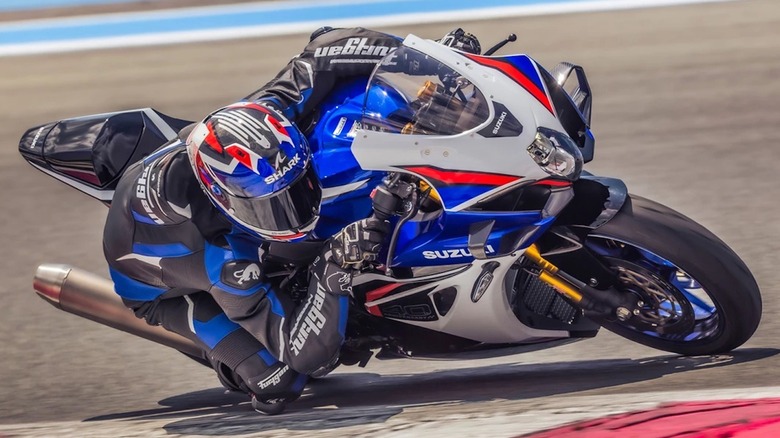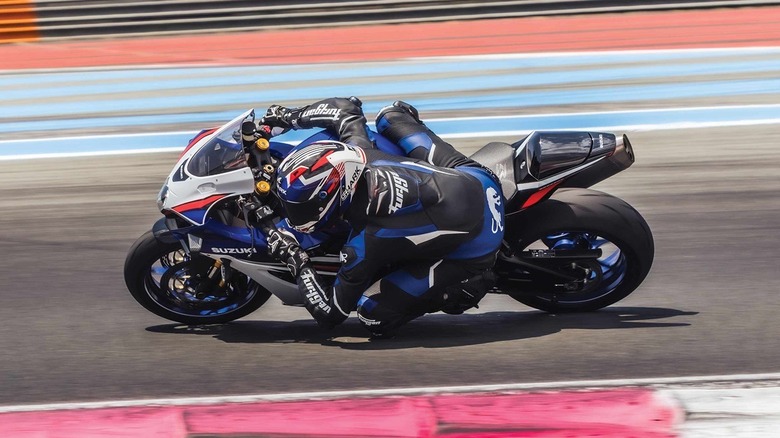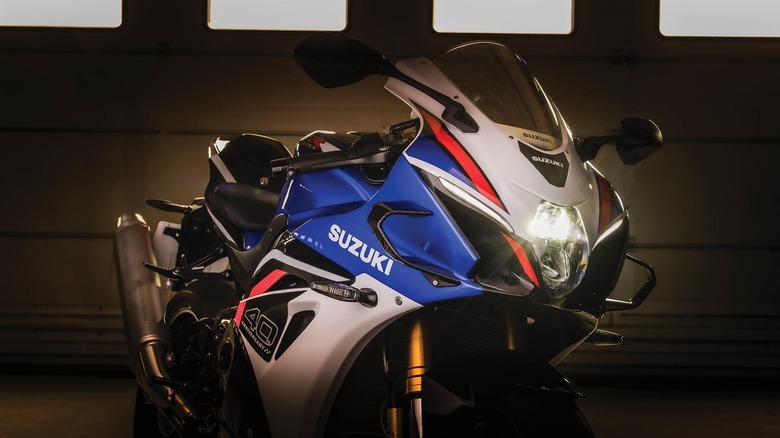How Fast Is The Suzuki GSX-R1000R & How Much HP Does It Have?
The Suzuki GSX-R turns 40 this year, and to celebrate, Suzuki has given one of its flagship sportbikes a big infusion of tech and performance. Not counting the top-speed monster known as the Hayabusa, the GSX-R1000R is the highest-performance sportbike in Suzuki's stable and, for 2026, it gets a heavily revised engine, new rider aids, and updated looks.
Like many motorcycle manufacturers, Suzuki doesn't list the output of its bikes in the United States. So, even though we know all about the changes to the engine (more on that below), we don't get official power numbers in the U.S. Thankfully, the overseas numbers are readily available, so we don't have to guess. According to Suzuki's U.K. specs, the newest GSX-R1000R puts out 192.3 hp (195 ps) and 81.1 lb-ft of torque (110 Nm). That's technically a small decrease from the previous model (down from about 199 hp), but that's still a lot of power for any bike.
A big motivating factor behind the updates for the GSX-R1000R's engine is compliance with Europe's newest emissions standards (Euro 5+) and other global emissions regulations. This is likely the main reason for the power decrease. Since it hasn't hit the streets just yet, we don't know exactly how fast the new GSX-R1000R will be, but with nearly 200 horsepower and a relatively light curb weight of 448 pounds, it's bound to be extremely quick.
More specs and some non-engine changes
Powering the 2026 GSX-R1000R is a 999.8cc (it's that last 0.8 that gets ya) four-cylinder engine with a bunch of updates: the crankcases, crankshaft, cylinder head, and head gasket are all new, with a new oiling system to keep the camshaft properly lubricated. The 2026 GSX-R1000R also gets a new 4-2-1 exhaust with a titanium muffler. The muffler itself is smaller (down from 8.3 liters to 5.5 liters), and it looks significantly better on the bike's side profile. Suzuki says it retains the performance of the previous exhaust system. The GSX-R1000R's cam chain and sprockets also received updates. The 2025 model has 13.2:1 compression, while the new model shifts to 13.8:1 compression. Bore and stroke remain the same at 76.0mm x 55.1mm.
The engine isn't the only change introduced for 2026. The GSX-R1000R also gets several 40th anniversary paint and decal schemes, new front winglets (made to look like carbon fiber, though they aren't), a lighter battery and IMU (Inertial Measurement Computer), and an updated launch control system for faster race starts.
The competition is as hot as ever
Anything with two wheels and nearly 200 hp is in proper high-performance liter-bike territory, but the Suzuki isn't the only bike flexing these kinds of numbers. We've recently tested the Honda CBR1000RR and its ultra-high-performance variant, the Honda CBR-1000RR-R Fireblade SP, both of which offer stiff competition for the Suzuki. Then, of course, there's the Kawasaki ZX-10R we've also put through its paces, and which is one of our favorite bikes in the category. As always, the Yamaha R1 is also one of the top choices in the class, with big power and lots of racetrack capability.
Which one of these liter bikes wins the price war, though? Well, there's no word yet on just how much the 2026 GSX-R1000R model will cost, but the current 2025 GSX-R1000R has an MSRP of $19,249 (including $600 destination fee), so we expect that this new 40th Anniversary model will easily top $20k — and likely go a bit higher than that.


